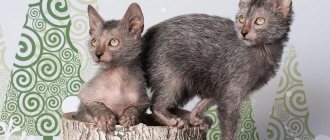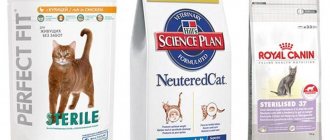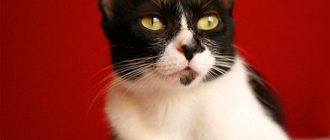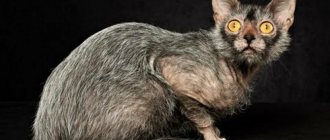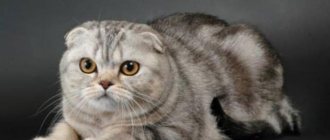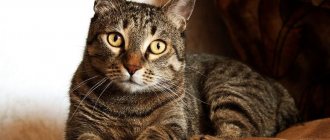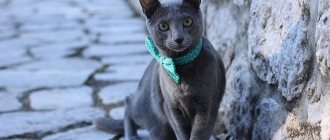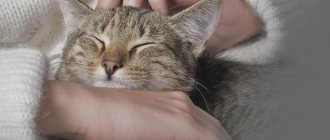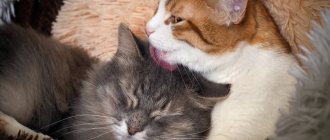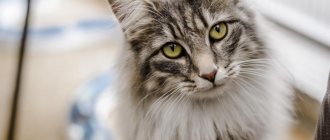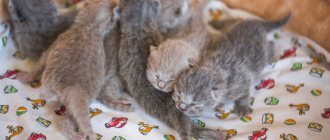Breed standard according to TICA classification
| Parameter | Grade |
| Head (40) | |
| Muzzle/chin/nose | 10 |
| Form | 10 |
| Ears | 8 |
| Eyes | 6 |
| Profile | 3 |
| Neck | 1 |
| Body (30) | |
| Frame | 7 |
| Musculature | 7 |
| Limbs/paws | 6 |
| Backbone | 6 |
| Tail | 4 |
| Coat (30) | |
| Texture | 15 |
| Color/pattern | 10 |
| Length | 5 |
General description : Likoi appeared as a result of a natural mutation from two domestic mongrel cats. Representatives of the breed are distinguished by a unique coat color, characterized as roan. The unusual color of the coat and its small amount give the cat an unusual appearance, reminiscent of a werewolf.
| Parameter | Description |
| Head | Shape: Modified wedge with rounded lines from nose to cheeks. The forehead is slightly rounded, slightly longer than wide. |
| Muzzle/chin/nose | Muzzle of medium length. Fleshy, softly rounded hairless whisker pads, pinch. The muzzle ends in a well-developed chin, aligned vertically with the nose, and having a rounded shape. The nose is bald, leathery to the touch, slightly pointed downwards and rounded at the end. There is a mask characterized by the absence of hair. |
| Ears | Large, wide at the base and pointed at the tips. Located high on the head, erect. The outer surface is covered with sparse hair. |
| Eyes | The large ones, shaped like a walnut, are directed obliquely upward. The expression of the eyes is open. There is no fur around the eyes. Golden eye color is preferred. |
| Profile | A concave curve from the forehead to the bridge of the nose. |
| Neck | Middle length. Neither thin nor overly muscular. |
| Body | Case: foreign type. The muscles are flexible and slender. |
| Limbs | The limbs are sparsely covered with hair, the paws may be hairless. Middle length. Paws are medium in size and oval in shape. The fingers are long. |
| Backbone | Average. |
| Tail | The tail is shorter than the body, tapering towards the tip. |
| Coat | The coat is not dense, soft to the touch, from short to medium length. The undercoat is minimal. The guard hair covering the body is long. The amount of hair varies depending on the season. In appearance, the fur resembles that of an opossum. |
| Color | Roan - ranging from 30% to 70% dark black hair from roots to tips, mixed with white hair from roots to tips. The ideal ratio is 50 to 50. White hair is distributed throughout the body. Individuals with a different coat color are allowed for breeding, but not for exhibitions. |
Outcrossing : shorthaired cats with a solid black color.
Disadvantages : sparse coat.
Disqualification:
- Absence of a bald mask on the face;
- Any primary coat color except black;
- No roan hair;
- The animal is completely covered with fur;
- Aggression or cowardice;
- In adult cats, the testes are not descended into the scrotum;
- Tail defects;
- Congenital mutations of the fingers;
- Strabismus;
- Blindness.
Description of Lykoi
Werecats differ from other members of the family in a number of unique qualities. They concern not only the color of the coat, but also the structure of the body.
Body
The Lykoy breed is distinguished by a regular, but slightly thin build. A slightly elongated body with flexible and strong muscles allows the animals to show both dexterity and power. The tail is long and tapering towards the tip, but it is shorter than the body. The weight of the Lika cat is average according to cat parameters.
Limbs
The well-developed thin paws of a werewolf cat are of medium length. At the same time, the hind limbs of catwolves are slightly shorter than the front ones. The lower part of the limbs is bare. The paw pads are medium sized and slightly oval in shape.
Head
The wedge-shaped head of cats has rounded edges and a slightly elongated forehead. The overall dimensions of the head are average or slightly less than average. The whisker pads on the muzzle are fleshy with soft outlines. The nose is slightly pointed downwards and has a soft rounding.
A prerequisite according to the breed standard is a bald muzzle. If this condition is not met, the cats will be disqualified. The werecat's large ears are characterized by a wide base and pointed tips. The ears are set wide apart.
The eyes, large as a walnut, are located slightly obliquely upward. Lykoi cats attract attention with an open and piercing gaze. Kittens are most often born with yellow irises.
Wool
The coat is a distinctive feature of the Lykoi cat breed. It is soft, but not dense. Hair length ranges from short to medium. The total number of hairs depends on the time of year. The undercoat is extremely weakly expressed. When comparing the fur of werecats, the most common example cited is the opossum.
The color of Lykoi cats is black with gray hair. In professional language it is called roan: the base of the hair is white or light gray, and the tip is black. If kittens are born in a litter that, along with the roan, have a different shade of fur, then they are left among the purebred ones, but are not allowed to take part in high-ranking exhibitions.
History of the origin of the Likoi breed
In 2010, two kittens with a unique appearance were born. The cat's owner, Patti Thomas, from Virginia (USA) contacted the breeders of Canadian Sphynx cats, the Gobble couple, because she believed that the kittens were somehow related to the breed. This theory was later refuted by a DNA test.
John Gobble, interested in unusual kittens, studied a lot of information and came across an article that talked about the birth of similar kittens in Tennessee, their mother was a black short-haired domestic cat.
In order to prove that a special gene is responsible for their appearance, the Gobble spouses deliberately attempted to breed cats. To do this, we took individuals from different litters. In 2011, a cat was born who was named Datiana. As a result, it was possible to establish that a recessive gene is responsible for the mutation.
All born kittens were examined, during which no genetic diseases, skin pathologies or diseases causing partial hairlessness were identified. It was possible to detect a lack of follicles, which explained the almost complete absence of undercoat, and to learn that cats shed to the point of complete hair loss.
Further work consisted of preparing documents and sending them to TICA in order to recognize the new breed. In 2012, the breed was officially recognized by TICA. Currently, the cats are bred in a cattery in Tennessee, from where the kittens went to breeders from the USA, Canada, and France.
Since the origin involved domestic outbred cats, they did not resort to the use of purebred animals in breeding. Subsequently, participation in the breeding of short-haired cats was reduced to a minimum. Breeders have focused on producing only black cats that carry the Lykoy gene. Outcrossing allows you to expand the gene pool and avoid the birth of sick kittens.
The history of the origin of cats similar to werewolves
global $ads_google;
//data-ad-slot=”2475549904″ $ads_google = empty($ads_google) ? false : true; ?> if ($ads_google == false) {?> $ads_google = true; ?> } ?> The Likoi breed , as has happened many times in the history of selection, appeared thanks to a happy accident. The year of birth of the unusual cat line is considered to be 2010, and the place is the American state of Virginia. An ordinary cat with short hair gave birth to kittens that partially lacked fur.
The owner of the strange pets was Patti Thomas. Because of their unusual appearance, reminiscent of characters from horror films, the American began to call her pets Lykoi. Subsequently, this word was enshrined in the name of werewolf cats.
Outwardly, the babies somewhat resembled sphinxes. And in order to understand the reasons for the appearance of wonderful offspring, the woman turned for help to the breeder and expert on Canadian Sphynxes, John Gobble. Having studied this issue in more detail, he found information that a similar case occurred in Tennessee with two more kittens. This was good reason to hope for the emergence of a new exotic breed.
As a result of genetic tests and studies, it was found that all four kittens have the same recessive gene in their genotype. For reasons unknown to scientists, a mutation occurred in it. It was she who was responsible for the birth of the Lykoi.
The work of breeders to consolidate traits very quickly yielded positive results. As a result of a specially developed breeding technique, in the fall of 2011, kittens of the second generation were born with the characteristics of the breed fixed in the genotype. Both pairs of the first “catwolves,” as well as short-haired cats, took part in these crossings.
Enthusiasts and professional breeders developed a standard by 2012, which was successfully approved by many world organizations of felinologists. Thus, Lykoi werewolf cats quickly entered the official list of cat breeds. But since very little time has passed since the appearance of the first representatives of purring “wolves,” they did not have time to become popular and widespread in the world, including in Russia.
Peculiarities
Several names for the breed were proposed, but the choice fell on “Likoy,” a word from Greek translated as “werewolf” and meaning a mythical creature that is reborn into a wolf. However, representatives of the breed did not arise in a mystical way, but through natural mutation and do not at all possess the features of a monster.
Lykoi has no genetic similarity to the Sphynx and Devon Rex. This fact is confirmed by the results of DNA tests carried out repeatedly.
The folded skin of the breed is very sensitive to high temperatures. Just a few hours in the sun and dark pigment spots appear on the skin, and exposure to sunlight for several days leads to a complete tan, with the skin becoming pitch black. The same effect is produced by exposure to heat, for example, if a cat sleeps on a radiator. But a few weeks without direct exposure to the sun and heat, and the skin takes on a natural pink color.
Appearance
It's amazing how quickly a breed with such a shocking appearance became popular among cat lovers all over the world. Lykoi are partially hairless cats with a unique coloration that is a combination of black and white hairs. There is a noticeable difference between cats and cats, it is visible even in the photo. Males are noticeably larger and more massive, their weight usually ranges from 4.5-6 kg, while cats weigh 2-3.5 kg.
The Lykoei mutation is individual, which is confirmed by comparative DNA analysis with sphinxes and Devon rexes. The baldness gene in Lykoi is recessive. Another DNA analysis showed that their color is not a tabby variety.
The head is medium-sized, wedge-shaped. The stop is not expressed. The nose is wide, slightly humped. The neck is long. The ears are wide at the base, high, slightly pointed. The distance between the ears is not large. The eyes are round, expressive, color: yellow, gray, green or blue. The hairless muzzle gave the Lykoi the amazing, easily recognizable appearance of a werecat. The body is compact, not too powerful, but not thin either, athletic, slightly elongated and flexible with a wide chest. Legs of medium length, medium sized tail.
Bald areas are located around the eyes, on the virris pads, on the chin and on the bridge of the nose. Almost all representatives of the breed have sparse hair on the front and hind legs, chest and belly.
The coat of the Lykoi is very soft, short, and sparse. Consists only of guard hair, the undercoat is completely absent. The degree of baldness in cats varies from person to person; some may be practically naked, while others are distinguished only by their “moth-eaten” muzzle. Another distinctive feature is the original roan color or roan.
Among cats, it is found only in Lykoeis. The skin is pink and tans quickly in the sun, like other hairless breeds. The most popular color is black and white, a pronounced roan, but cats can also have lighter coats, up to light gray, which in combination with white hairs and hairless areas makes them very light.
Personality of Likoy cats
Lykois are very attached to family members, making them considered ideal family pets. But only if they are taken care of and given attention. With those whom the cat trusts, she is affectionate and playful.
Animals prefer to spend more time with people, but if they happen to be left alone, cats find activities for themselves, for example, they enthusiastically play with toys or any other objects in the room. There is no need to be bored if there are several cats or a dog in the house.
Likoy reacts to strangers in the house with restraint and caution, anticipating potential danger. If there is a threat to itself, the cat may attack or bite, which is especially true for curious or aggressive dogs. But some time after meeting, having ruled out a threat to himself, the stranger will receive a friendly attitude from the cat.
Lykoi can make a person feel uneasy with just a glance. Sometimes it seems that cats look through a person with open yellow eyes, they are able to read thoughts, their gaze is so soulful.
Smart cats show intelligence when solving problems that arise during the game. They do an excellent job with intellectual toys, finding ways to achieve a goal, for example, getting a parrot out of a cage.
In terms of temperament, Lykoi are compared to hound breeds of dogs, endowed with an excellent sense of smell and distinguished by a developed hunting instinct. If there are other pets living in the house, for example, a parrot, a hamster, then they can become prey for Lykoi. The cat will bring its prey to its owner’s feet without the slightest embarrassment. Lykoi love to hunt and do it excellently. Toys and the owner's legs can become objects of hunting. The prey instinct manifests itself most strongly during the game.
Maintenance and care
Unlike other breeds, the Lykoi needs more frequent bathing, because a coating of sweat forms on the bare areas of the body. Bathing can be replaced by cleansing the skin with wet wipes. By the way, cats of this breed have a negative attitude towards water.
Clean the ears once a week and regularly monitor the condition of the eyes. It should be noted that the claws of representatives of the breed grow quickly. They also need weekly care.
Lykoi shed intensively, all hair may fall out during the molting period. Over the course of a year, animals grow new hair, which is darker or lighter than the old one and can cover the entire body.
Lykoi kittens
Externally, kittens are almost no different from adults. They look ragged and awkward with prominent large ears. Kittens are born with a variety of coat colors, but only those with solid black roan coats are accepted for exhibition.
It is noteworthy that kittens are born with solid black fur. But after the first molt, at two to four weeks of age, new white and black hairs grow. The color is called “roan” and is found in dogs and horses. DNA analysis showed that the pattern is not tabby.
From birth, kittens have no hair around the eyes, chin, nose and outer top of the ears. The ears and nose are leathery to the touch. The legs of most individuals are covered with sparse hair.
Mature males can be significantly larger than females.
